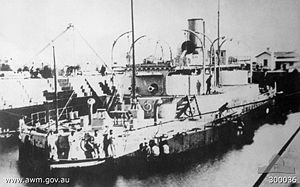- Cerberus class monitor
-

Stern view of Cerberus at Williamstown, Victoria in 1871Class overview Builders: Thames Ironworks and Shipbuilding Company
Palmers Shipbuilding and Iron CompanyOperators:  Royal Navy
Royal Navy
 Royal Australian Navy
Royal Australian NavyBuilt: 1867–1870 In commission: 1870–1924 Completed: 2 General characteristics Displacement: 3,344 long tons (3,398 t) Length: 225 ft (69 m) Beam: 45 ft (14 m) Draught: 15 ft 4 in (4.67 m) Propulsion: 2 shaft Maudslay, 1,360 ihp (Cerberus)
2 shaft Ravenhill 1,436 ihp, (Magdala)Speed: 9.75 knots (11 mph; 18 km/h) (Cerberus)
10.6 knots (12 mph; 20 km/h) (Magdala)Complement: 155 Armament: 4 × 10-inch (254 mm) (2×2) Rifled Muzzle Loading guns Armour: Belt: 6–8 in (150–200 mm) with 9–11 in (230–280 mm) wood backing
Turret: 9–10 in (230–250 mm)
Breastworks: 8–9 in (200–230 mm)
Deck: 1–1.5 in (25–38 mm)Cerberus class monitors were a class of breastwork monitors constructed in the late 19th century for the Royal Navy.
Contents
Design
Also referred to as "ironclads" and "turret ships", the ships of the Cerberus class were designed by Sir Edward Reed following requests by several dominions and colonies of the British Empire for warships to be used as coastal defence ships. The class consisted of two ships: HMS Cerberus, which was operated by the colony of Victoria, and HMS Magdala, which spent her life operating in Bombay Harbour.
The size of the ships was limited by cost. They were designed and built to be used as local defence ships, and it was not expected that they would ever need to be deployed far away from their bases. It was therefore possible to design them without sails or rigging and dependent only upon their engines, with a resulting limitation in their effective range.
The absence of masts and rigging allowed more weight to be worked into the ship's armour. This also meant it was possible to arm the ships with two gun turrets, one fore and one aft, which had wholly unobstructed fields of fire over the bow and stern, and on wide arcs amidships. The turrets were mounted on the upper deck and hence had a greater height above water and a correspondingly greater command than guns mounted on the main deck. The turret armament provided an additional advantage of allowing the ships to have a low freeboard. This increased the steadiness of the ship and allowed the hull armour to be applied more thickly over a more limited height of exposed hull.
Construction
Ship Builder Laid down Launched Completed Fate Cost HMVS Cerberus Palmers, Jarrow 1 September 1867 2 December 1868 September 1870 Scuttled as breakwater, 26 July 1924 £117,556[1] HMS Magdala Thames Ironworks, Blackwall, London 6 October 1868 2 March 1870 November 1870 Sold 1903 £132,400[1] Ships
- HMVS Cerberus- harbour defence vessel at Melbourne, Australia
- HMS Magdala - harbour defence vessel at Bombay, India
See also
- HMS Abyssinia - harbour defence vessel at Bombay, India, built to a similar, but smaller, design.
Notes and references
Footnotes
Sources
- Archibald, E.H.H. (1971). The Metal Fighting Ship in the Royal Navy 1860-1970. New York: Arco Publishing Co. ISBN 0-6680-2509-3.
- Brown, D.K., Warrior to Dreadnought, Warship Development 1860-1906, ISBN 1-84067-529-2
- Colledge, J. J.; Warlow, Ben (2006) [1969]. Ships of the Royal Navy: The Complete Record of all Fighting Ships of the Royal Navy (Rev. ed.). London: Chatham. ISBN 978-1-86176-281-8. OCLC 67375475.
- Fuller, Howard (December 2005). ""A portentous spectacle": The Monitor U.S.S. Miantonomoh Visits England". International Journal of Naval History 4 (3). http://www.ijnhonline.org/volume4_number3_dec05/dec05%20PDFs/Fuller%20article.pdf. Retrieved 2008-11-27.
- Gardiner, Robert, ed (1979). Conway's All the World's Fighting Ships 1860-1905. Greenwich: Conway Maritime Press. ISBN 0-8317-0302-4.
- Parkes, Oscar (1990). British Battleships (reprint of the 1957 ed.). Annapolis, MD: Naval Institute Press. ISBN 1-55750-075-4.
External links section
Cerberus-class monitorCategories:- Monitor classes
- Cerberus class monitors
Wikimedia Foundation. 2010.
